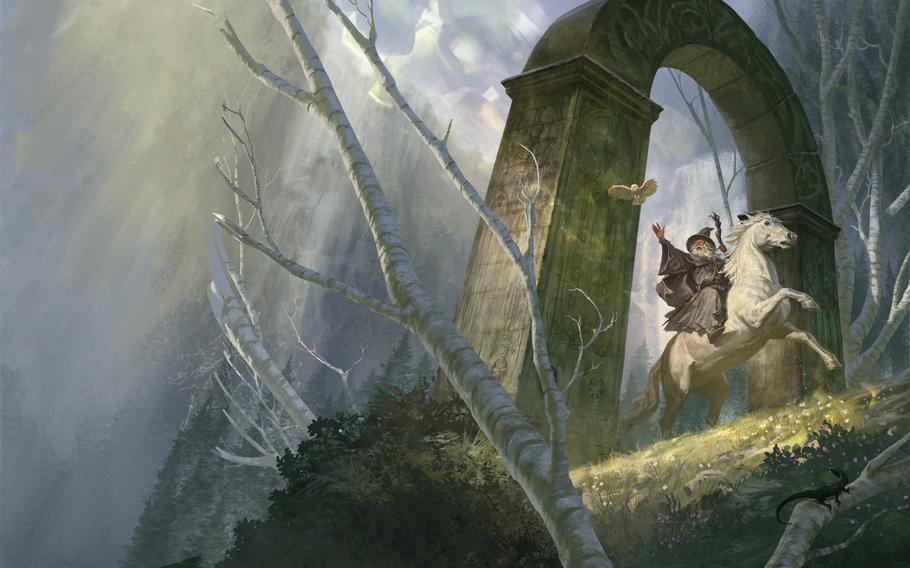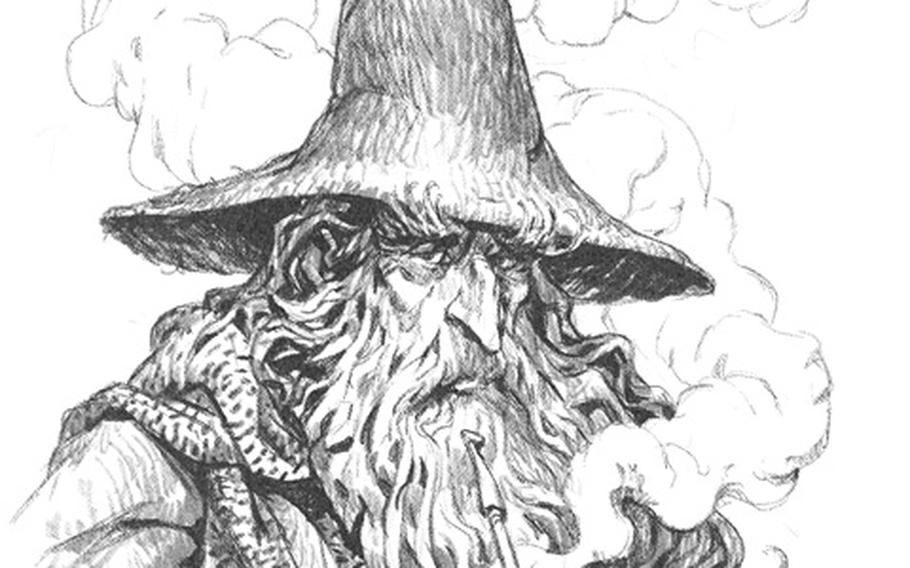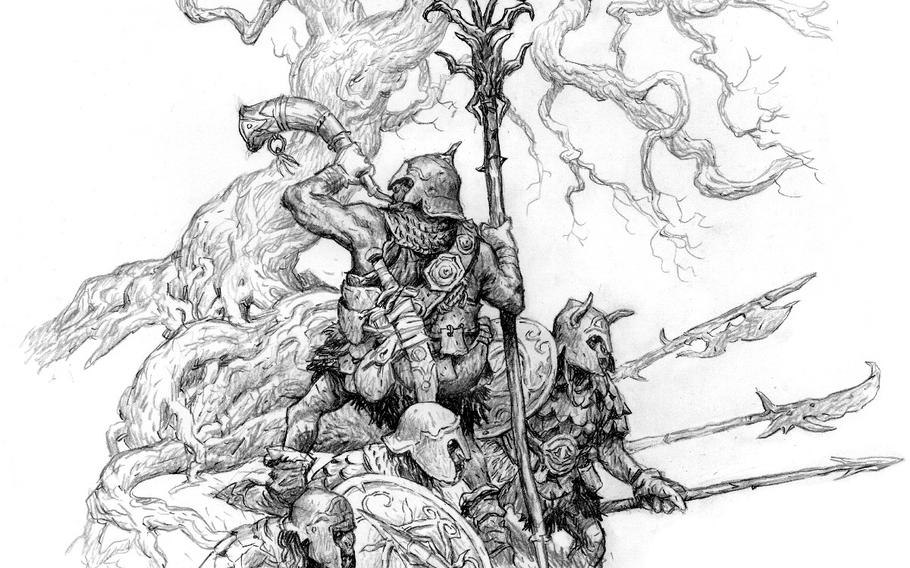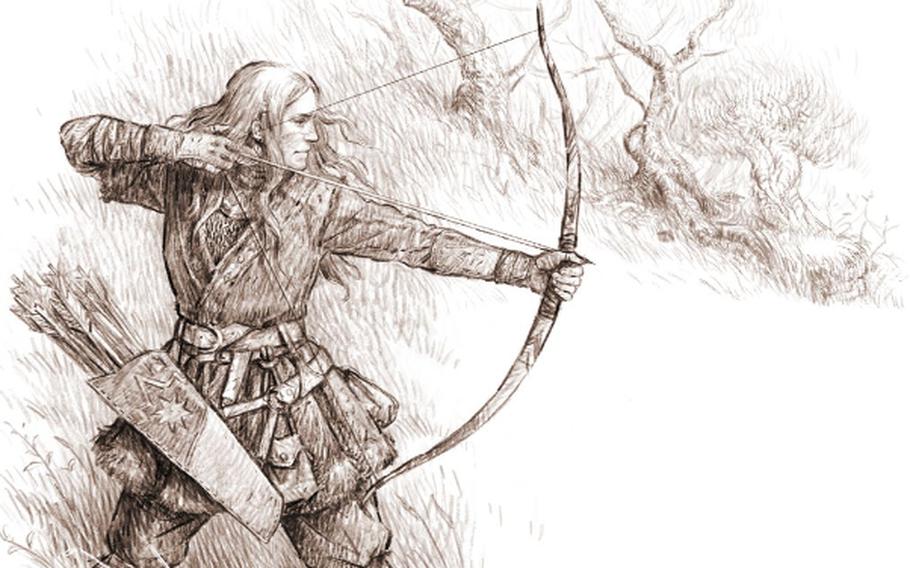
Adventurers wade through flooded subterranean chambers as they battle undead enemies in a recent Lord of the Rings Roleplaying game in Washington, D.C. (Brian Bowers/Stars and Stripes)
Many think of Dungeons & Dragons as a tabletop roleplaying version of J.R.R. Tolkien’s “The Lord of the Rings.”
However, Frodo never pulled out a Wand of Magic Missiles to blast an orc. And Aragorn never worried about being enveloped by a quivering Gelatinous Cube. There isn’t all that much magic in “The Lord of the Rings” – at least not like the arcane spectacles players expect when playing D&D. And the wicked beasties populating Middle-earth are a lot less diverse than those contained in the D&D “Monster Manual.”
For those looking for a fantasy world a lot closer to Tolkien’s Middle-earth, Free League Publishing has created The One Ring and The Lord of the Rings Roleplaying. The two games are basically the same, but LOTR Roleplaying relies on rules for D&D’s fifth edition – a format that’s popular for its accessibility and focus on fun.
Since I’m most familiar with D&D 5e system, I opted to give that version a shot.
The 5e rules are so thoroughly integrated into the game’s format that the core rulebook doesn’t even cover points that are the same. That means, for example, that the rulebook doesn’t cover combat except to direct players toward the rules in the D&D “Player’s Handbook.” However, don’t think that you will need to plunk down another $50 for the D&D handbook. The basic 5e rules are available for free to download on PDF from the website of D&D’s creators, Wizards of the Coast.

Gandalf appears on the cover are for the core rulebook of The Lord of the Rings Roleplaying game. (Free League Publishing)
The Lord of the Rings core rulebook focuses on differences between the freewheeling nature of D&D and the sort of gameplay necessary for a world that’s closer to that in Tolkien’s works.
The differences include seemingly small things, like redefining what constitutes a long rest and what skills are available to characters. But each brings the game more in line with Tolkien’s world. For example, D&D’s “arcana” and “religion” skills have been eliminated because they aren’t relevant and “explore,” “hunting” and “travel” have been added to reflect the skills needed by long-distance travelers.
Other changes are more significant.
The game whittles the number of character races down to human, elf, hobbit and dwarf – eliminating dragonborn, gnomes, devilish Tieflings, catlike Tabaxi and a slew of others. Humanity is divided into three branches – Rangers, men of Bree and Bardings, each with its own characteristics and bonuses.
The game also reworks adventures’ job titles – referred to them as “callings” rather than “classes.” The fighter callings are: captain, think of Boromir; champion, a standard fighter; and warden, think of Aragorn and the ranger class in traditional D&D. The rogue class has become the treasure hunter calling. And elements of the bard and monk, along with a hint of roguishness, appear in the messenger calling.

Gandalf enjoys a pipe in an illustration from the core rule book of The Lord of the Rings Roleplaying game. (Free League Publishing)
Gone are clerics and sorcerers, since Tolkien never mentioned priests and only a handful of extremely powerful wizards – like Gandalf – inhabited Middle-earth. All of D&D’s magic-using classes are replaced by the calling of scholar, which can focus on either lore or healing. Instead of casting powerful spells – hurling fireballs or raising fallen comrades from the dead – characters perform “crafts” that can influence the course of the action in more subtle ways. Crafts enable characters to heal, communicate with animals, boost weapon skills, read runes and more. Unfortunately, there are only eight basic crafts to choose from instead of the scores of spells in D&D.
When characters reach a new level, they gain rewards – such as new weapons or armor – and can select from a list of their culture’s virtues, which boost certain skills and abilities.

Orcs ambush a party of adventurers in an illustration from the core rule book of The Lord of the Rings Roleplaying game. (Free League Publishing)
In addition to recasting the nature of gameplay, the game adds several mechanics that bring things into line with the narrative flow of both “The Hobbit” and “The Lord of the Rings.” It places a greater emphasis on the journey to the adventure site. Mishaps or boons that occur during the trip can affect the party’s status and health before they even face their first Orc. This explains the addition of the journey-related skills.
And in a nod to the many meetings between the Fellowship of the Ring and powerful kings, councils, stewards and wizards, the game includes mechanics covering such interactions. This involves a series of dice rolls weighted by the party’s status and the seriousness of the matter being discussed.
One of the most significant new mechanics involves the looming evil that seeks to dominate Middle-earth. Players will frequently acquire Shadow Points. Perhaps they greedily picked up treasure that had been tainted by Orcish hands or stupidly killed an innocent villager. These actions generate Shadow Points, which can eventually lead to a bout of madness. Think of Gollum, or even Boromir’s breakdown when he tried to take the One Ring from Frodo. There’s also the problem of Sauron’s ever-watching eye. Certain deeds – good or bad – can draw his attention and cause problems for the party.

Orcs rally in an illustration from the core rule book of The Lord of the Rings Roleplaying game. (Free League Publishing)
Another addition is the presence of patrons – figures who impart advice or present quest opportunities. They also grant certain bonuses to the party. Most patrons are familiar to Tolkien fans, including the adventurer Bilbo Baggins, the wizard Gandalf, the dwarf Balin and the mysterious and mischievous Tom Bombadil.
Finally, the game features a Fellowship Phase at the end of each adventure. During this time, the party gathers to recuperate and undertake special tasks. The best example of this in Tolkien’s books is the sojourn at Rivendell after Frodo was wounded.
During the Fellowship Phase, characters are able to remove some Shadow Points, meet with their patron, gather information, study magical items or bolster the fellowship and gain Fellowship points. These points can be spent to gain advantage on various dice rolls during the adventure. Advantage lets you roll the die twice and use the best score.
However, the game is not a retelling of “The Hobbit” or “The Lord of the Rings.” Its action is set between the two works. Smaug the dragon has been eliminated and the surrounding region is thriving. Sauron is reemerging as a shadowy threat, but his armies are not yet marshalling.
To help players and their “Loremaster” immerse themselves in this world, the core rulebook outlines the people, places, enemies and lore of Middle-earth.
These are expanded upon in additional volumes titled “Ruins of Eriador,” “Tales of Eriador” and “Shire Adventures,” for those who prefer the pint-size hobbits. These well organized and pleasingly illustrated volumes contain additional background information as well as adventures that are ready to play.
But you can only go so far by reading and comparing rule books. That’s where my friends and family came in handy.

An archer takes aim in an illustration from the core rule book of The Lord of the Rings Roleplaying game. (Free League Publishing)
I acted as Loremaster for two different groups of players, leading them through an adventure featured in the core rule book. It revolved around cutthroat brigands, soggy ghouls, skulking dwarves and a noble wraith in a ruined city cursed by the infamous Witch-king of Angmar.
Although as Loremaster, I had to do quite a bit of study to familiarize myself with the new format, the players discovered that the reliance on 5e rules made the transition very quick and smooth.
As could be expected, one of the elven scholars grumbled a wee bit about stepping back into a bard-like supporting role in combat, but even he gave the overall package glowing reviews. The champions, wardens and treasure hunters were all pleased with the new abilities – and with the relative lack of magic, which permitted them to focus on combat without having to worry about being blindsided by a powerful spell.
In fact, most felt the loss of magic was balanced by the abilities gained across the board. For example, one of the hobbit treasure hunters reveled in his use – and probably abuse – of a rule allowing him to move in combat without provoking opportunity attacks. This permitted him to flit across the battlefield dealing deadly sneak attacks almost at will.
But the whole reason to play this game is to immerse yourself in Tolkien’s world. That too was a success. Bumping into Bilbo Baggins, drinking ale at the Prancing Pony in Bree and fighting familiar foes brought Middle-earth to life.
In addition, the players thoroughly enjoyed the well-constructed adventure, which provided ample opportunities for action and interaction. They said this – as well as the game’s unique rules – encouraged actual roleplaying rather than just enduring a string of shallow skirmishes.
They embraced it all and are planning their return for more adventure in Middle-earth.
Online: freeleaguepublishing.com/games/the-lord-of-the-rings-roleplaying